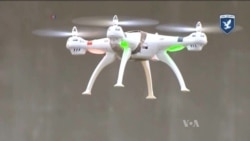An estimated 1 million drones were sold over the 2015 Christmas holiday period in the United States alone. The explosion in their popularity – and the plummeting price tag - has prompted some concern over the potential dangers of drones. But there is also recognition of the huge benefits the technology could bring.
An eagle grabbing a drone in its talons and taking it down is billed as a low-tech solution to a high-tech problem that police in the Netherlands are taking seriously. They envisage using the eagles against drones that fly into restricted air space, or above a public event.
Sjoerd Hoogendoorn - who came up with the idea – says there's no danger to the eagles themselves
"The birds are naturally protected from bites of prey by scales on their talons so that's a natural protection that the eagle has,” he said.
These days, cheap consumer drones can be bought for around $50 and up. Criminals could exploit the technology, warns drone expert Hulsey Smith of U.S.-based Aero Kinetics.
“A toy drone could be utilized just to provide fear, regardless of actually instigating some sort of terrorist attack or otherwise. It could be accidentally flown into a crowd of people,” he said.
Smith says one of the biggest dangers is to aviation.
“In the event of a collision between a toy drone and a helicopter, such as an emergency medical helicopter or otherwise, it would ultimately prove a fatality," he said. "As you evaluate the same risk structure to commercial aircraft, if a toy drone was to be ingested into a British Airways flight or an American Airways flight on take off, it would result in a catastrophic engine failure.”
But there is also great potential. At the second annual ‘Drones for Good’ competition in Dubai earlier this month, the focus was on the benefits drone technology can offer. The winner, Talib Mohammed al-Hanai, designed a drone that can remotely seal dangerous leaks in oil and gas pipelines.
"We wanted a drone that doesn’t just search for leaks, but one that can also fix it on the spot and protect the lives of the people,” he said.
The potential is huge, says Hulsey Smith.
“Imagine being able to move defibrillators to heart attack victims faster than ever before possible. Imagine the ability to keep construction workers from having to climb roofs to do an inspection after a storm," he said. "And imagine the ability to find lost children in nature where you couldn’t fly manned aircraft.”
As the industry rapidly expands, experts say the potential benefits – and the possible dangers – are still being understood.
LONDON —











